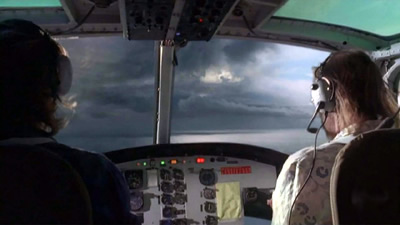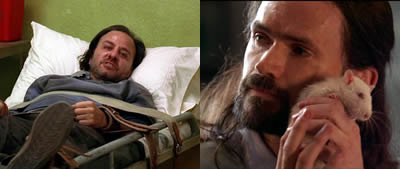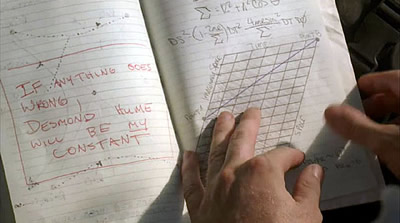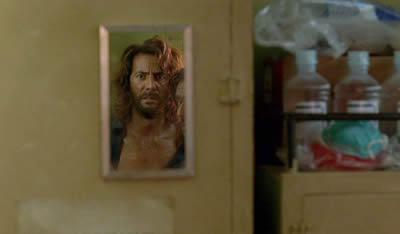"I think I've just been to the future":
A Structural Analysis of The Constant
A Structural Analysis of The Constant
The Sign of Two
The Constant in Lost
Notes
A Structural Analysis of The Constant
I offer this structural analysis of The Constant as a framework that might be mapped onto other episodes of Lost. My assumption is that The Constant – as did the Desmond-centric Flashes Before Your Eyes from season two – hints at and, in some respects, explicitly mirrors overall themes in the show. My analysis focuses on parallel narrative structures, and assumes that the narrative is driven by Desmond's traumatic experience, the resolution of which will properly close the narrative.
An omniscient narrator introduces The Constant, as the preface of a book might introduce the setting of a novel, returning us to the helicopter seen leaving the island last week, and to the journey of Frank, Desmond and Naomi's corpse to the freighter from the island. Until, that is, the electrical storm hits, and the story proper begins.

At that point Desmond's consciousness functions as the narrator, and the action of all other characters serves as a counterpoint to Desmond's journey. The general and fellow soldiers in Desmond's past play similar roles to those of the doctor, Keamy and Omar in Desmond's present. Each group confirms through physical duress and the imposition of their will the reality of both 1996 and 2004 (note that each reality contains an authority figure - the general and the doctor - along with underlings, whose job is to calm Desmond and encourage him to accept each authority figure's rule). I will label these characters the Stock Players. Further parallel functions abound, as detailed below.
The Mirror: this character confirms the possibility of internal time travel, and serves as both a reflection of Desmond and as a counterpoint to the mundane - and therefore possibly false - appearance of stock players. The Mirror in 2004 is of course George Minkowski (the freighter's apparently time-traveling communications officer), while the 1996 Mirror is Eloise (a white rat subject to Daniel Faraday's surreptitious experiments).

The Witness: this character serves as an external witness to the possibility of internal time travel, and links the Mirror to Desmond in each timeline. The Witness in both 1996 and 2004 is of course Daniel Faraday (Frank and the Stock Players see Desmond's condition as an echo of the amnesia suffered by Brandon and George, but there is no evidence that the Stock Players consider the afflicted men more than simple "head cases").
The Unexpected Friend: Desmond encounters this character is either an unknown or possible foe, but in each timeline the UF gives Desmond the key to resolve the trauma of his experience (the experience and resolution of trauma is, of course, the true narrative drive of "The Constant," since we never actually discover whether the time travel has abated, only a confirmation that Desmond's life and sanity will apparently be spared). The UF in 2004 is Sayid (who fixes the phone), while the UF in 1996 is Charles Widmore, who in a surprising move gives Desmond his daughter's new address (Penelope Widmore, Desmond's ex-fiancée).

Penny as The Constant links both realities, but her role cannot be "activated" until the other players have completed their roles in the narrative. Therefore Penny's aborted 1996 phone conversation with Desmond marked her as a Stock Player until he met with the Witness, after which the Unexpected Friend had to provide the means to activate The Constant. The same scenario plays out of course in 2004: Frank asserts that whatever happened to Desmond has occurred before, prompting a call to the island and Faraday as Witness to initiate the final arc: the resolution of Desmond's trauma.
A parallel journey is played out in each timeline, from beleaguered soldier/prisoner-patient to empowered, autonomous suitor who has accepted his plight and taken action to resolve it as best he can. Both the Witness and the Protagonist conveniently forget their first meeting (invoking either Inappropriate use of summary narration or the Novikov consistency principle), and their roles are switched at the end, when Desmond becomes Faraday’s Constant and thus, implicitly, his Witness in the future.

The Sign of Two
Numerous signs index the ways in which Desmond’s past and present journeys mirror one another, and most come in pairs. I begin with the episode’s title. A constant could refer to many things, but becomes an alias for one person, Penny, whose connection to Desmond remains the emotional heart of Lost’s expanded journey into the Real World. In a plot analog to the theory of relativity, Penny plays lightspeed while time flies, crawls or skips wildly from one point to another, until her function as Constant transfers Desmond at the end. The Lost number eight denotes years and events: eight years pass between Desmond old and Desmond present, and eight flashbacks chart the missing time and missed attempts at communication and understanding that plague the Protagonist until the moment he makes contact with his Constant.
Water is everywhere, taking two forms: bad weather (the storm in the 2004 Pacific and 1996 Scotland), and cleansing ritual (washrooms on the freighter and at Southfields auction house). There are two journals, there are two people who “aren’t supposed to be here,” there are two means by which communication is breached, broken and occasionally made (phones and notes). Communication is difficult in both past (thwarted calls from Desmond to Penny, instructions from the Scottish sergeant to his troops and furtive notes passed in the men’s toilet) and present (between ship and shore, and ship and outside world, between the freighties and Sayid and Desmond). As a dramatic device, communication miscues build enormous tension directed towards the successful completion of Desmond’s call to Penny.

Structural parallels extend, in true Lost fashion, far beyond the edges of the The Constant itself. Desmond repeats his own actions: joing a monastery after breaking up with Ruth and the army after leaving Penny, and names from the past reappear (Billy, Danny, Frank, Hanso, Millar, Omar, Ray, Hawking [on Farady’s blackboard]).1 Fish Biscuit’s essay at darkufo reminds us that Frank’s helicopter heading of 305 echoed a scriptural reference on Eko’s “Jesus stick.”2 J. Wood sees a connection between Eloise the rat and her French ancestors, the 12th century abbess Heloïse and the heroine of Jean-Jacques Rousseau’s Julie, or the New Heloïse, protagonists whose romances, ala the Odyssey, the travails of Desmond and Penny.’3
The Constant in Lost
The power of this episode resides not only in its tight pacing, Cusick's wonderful acting, and clever, parallel narrative structure, but in the way this single episode reflects the various mirror narratives embedded in Lost from the beginning. These include equivalent plots involving past vs. present, present vs. future, island life vs. off-island life, character narratives on and off the island, and characters as empowered leaders vs. meek followers. The climactic moment where Desmond 2004 reaches Penny and Desmond 1996 smiles ever so slightly invokes the notion that consciousness may transcend time via the communication of particles at the quantum level (Bell’s theorem on nonlocality); careful viewers of The Constant may extrapolate Faraday and Hume’s connection to others in the Lost universe. The subtle interplay of Witness and Protagonist explains why the manifold character connections are intrinsic to the series: the actions of any one character in past or future may be irrevocably tied to those of another.
Luhks suggests in a review on darkufo that Lost as long-running series charts an epic narrative that viewers increasingly see as a “four-dimensional” whole.4 Does “The Constant” thus provide a kind of constant for Lost the series? Its tight internal structure never distracts from the heart and soul of the narrative. Yet that parallel construction trains the dedicated viewer to treat the people and events of Lost as a huge mosaic. In Lost the series, structural associations reach across space and through time, within individual scenes as well as among episodes and seasons, and perhaps, in the end, beyond the show itself.

Amy Bauer
Notes
1 See a comprehensive list of Lost names at Lost is a Game, http://lostisagame.com/duplicates.htm#A60. back
2John 3:05: Jesus answered, "I tell you the truth, no one can enter the kingdom of God unless he is born of water and the Spirit. Des and Dan’s Excellent Adventure, http://darkufo.blogspot.com/2008/03/des-and-dans-excellent-adventure-by.html, accessed March 27, 2008. See also the essay in this journal, The (Many) Meanings of Eko’s Jesus Stick. back
3 The Constant & Non-Local Brain Games, at J. Woods blog at powell’s books, http://www.powells.com/blog/?p=2987, accessed March 27, 2008. back
4 “In the long run, flashbacks and flash-forwards might be meaningless terms. If we go further back, then all of the events of Lost can be seen as a flash-forward. If we go far enough ahead, then everything can be seen as a flashback. Either way, the entire story begins to resemble a Constant, a permanent and unchanging whole.” The Heart and The Head, http://darkufo.blogspot.com/2008/03/heart-and-head-by-luhks.html, accessed March 27, 2008. As many reviewers have noted, the episode explicitly references Kurt Vonnegut’s Slaughterhouse Five, when Daniel notes that Eloise is “unstuck in time.” I found Luhks essay one of the most satisfying explorations of the Vonnegut connection. One topic beyond the scope of this essay is whether parallelism in The Constant, as well as Flashes, suggests that history in Lost is as malleable as the future (that is, either both are fixed or both are flexible). The idea that Desmond and other characters may be caught in a time loop is explored by Vozzek69 in Things I Noticed - The Constant, http://darkufo.blogspot.com/2008/02/things-i-noticed-constant-by-vozzek69.html, as well as by onbarnett’s theory “The Moment After the Absolute Present,” posted at losttv-forum.com, http://www.losttv-forum.com/forum/showthread.php?t=47631.
back